You will be collected between 08:30 & 09:00.
We will travel north, stopping at small towns along the way including Okahandja, where we have time to visit Namibia’s largest wood carving market. The market is operated on a local co-operative basis and is one of the best places to shop for truly Namibian souvenirs. Continuing north, passing through farmland, we aim to arrive at Mount Etjo Safari Lodge during the middle afternoon.
‘Etjo’ means a place of refuge. Since 1975 Mount Etjo Safari Lodge has been the heart of the Okonjati wildlife sanctuary, offering African wildlife and guests from around the world more than just a place to stay, but a safe haven, tranquil surroundings and the opportunity to engage in the pristine beauty of African wilderness. At Mount Etjo Safari Lodge, the African traveller will leave with his heart and mind enriched and his soul set at ease by having found peace and harmony in the African natural world.
The vibrant bird life at the Lodge is testimony to the beautiful gardens at the Lodge. Enormous palm trees, endless grass fields and a flamingo pond invite you to take a walk and a look around. The Lodge is built to face a large lake where animals regularly quench their thirst and hippos come to visit. Further in the distance lingers the magnificent Mount Etjo mountain, completing the picturesque scenery.
The unique architecture of our rooms, furnished and beautifully decorated in a splendid combination of luxury and African style will contribute to the exceptional experience of staying at Mount Etjo Safari Lodge. The Lodge is furnished with 22 luxury rooms, each with en-suite bathroom. Most of the rooms are situated next to the swimming pool which overlooks the watering hole where numerous animals come to drink during the day and night, while others overlook the spacious garden where the flamingos frolic. Various types of accommodation is available to suit the personal needs of young and old. The Lodge is fully wheelchair-friendly.
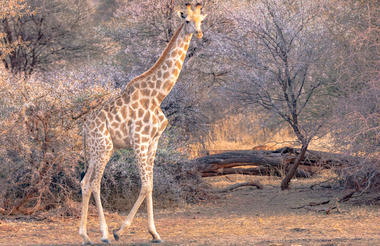
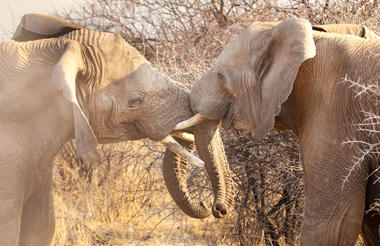
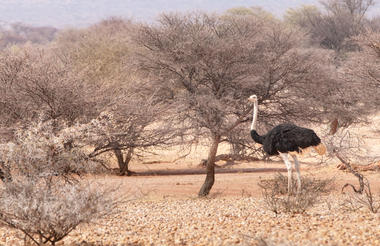
An early start and continuing north we pass through some small towns, making short stops for fresh supplies and fuel.
Continuing on to our East Etosha, Namutoni region camp we again aim to arrive in time for lunch, giving us time to relax before heading into the park during the cool of the late afternoon for our first game drive.
The lodge centres on an old German Fort overlooking the King Nehale waterhole; an elevated decked walkway provides excellent opportunities for enjoying the surrounding scenery, wildlife and the spectacular sunsets. The Fort has been developed into a hub of activity, offering two restaurants, a relaxation lounge, a bar, crafts boutique, curio shop, jewellers and bookstore. Accommodation is provided in comfortable double rooms or bush chalets.
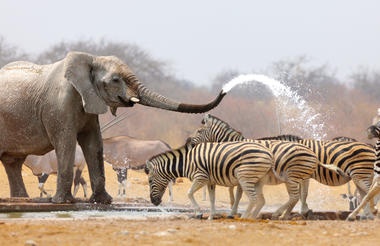
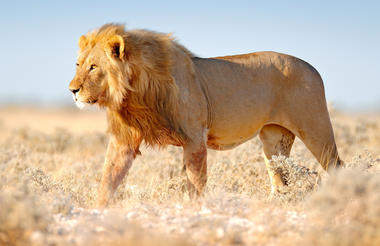
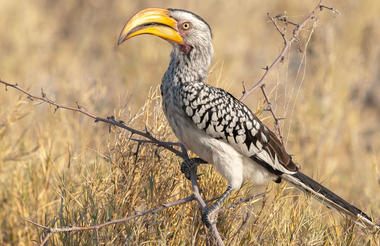
A full day’s game driving. We again leave early to enjoy the cool morning air as we game drive our way through Etosha to Halali camp, situated in the middle of the park. Along the way we visit several waterholes and are afforded splendid views of the massive Etosha Pan. The game viewing is usually excellent and we have the chance to tick off a few new species that are not normally seen on the Namutoni side of the park.
We stop at Halali for a rest and a leisurely lunch. There is time to visit the Halali waterhole and to make use of the swimming pool and bar facilities before continuing on our way and game driving down to Okaukuejo, Etosha’s main rest camp and resort where we will check in and set up camp. Originally the site of a German fort built in 1901, Okaukuejo now houses the Etosha Ecological Institute, founded in 1974; the round watchtower is a remnant of the fort.
After your evening meal there are still more chances to see Etosha’s big game at a floodlit waterhole, situated on the boundary of our camp and easily reachable within a minute or two on foot.
The waterhole has been described as one of the “best game viewing opportunities in Southern Africa” and the ideal venue to witness peculiar animal politics. Black rhino, Africa’s tallest elephants, lion and numerous species of antelope are regular visitors during the cool, dry season.



Today we travel through the previously restricted area of Western Etosha National Park, exiting via the Otjovasandu Gate. Overnight at the Hobatere Lodge.
The name Hobatere means “Find me”, and once you do, you will enjoy a warm welcome and personalized service.
Hobatere Lodge is located 80 km north of Kamanjab on the western border of the Etosha National park, situated in a concession area of 32 000 ha, which is home to a wide selection of game including Lion, Leopard, Oryx, Eland, Cheetah, Giraffe, Hartmann’s Mountain Zebra and Elephant. The activities centre around day or night game drives, bird watching and guided walks, affording guests ample opportunity to view the abundance of wildlife and endemic species in the area. (Activities are optional and not included) The Lodge also have a hide overlooking a nearby waterhole and a sundeck with panoramic views, which is floodlit for part of the night.
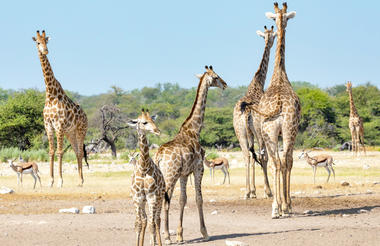
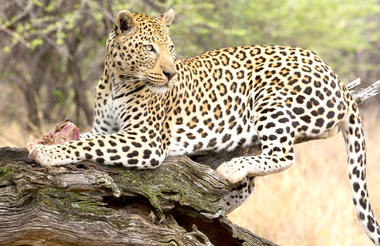
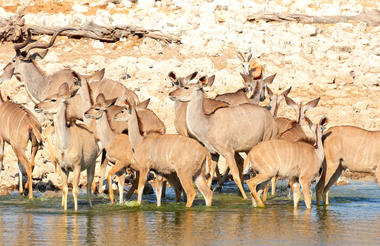
Within this area you have the opportunity of visiting a Himba Village – the only traditionally functioning Himba community outside the far north Kaokoland region of Namibia These tribes-people have migrated here, lifestyle and customs intact, and are following their traditional way-of-life in their village on a farm, the exact location of the site varies as the Himba occasionally roam to a new location. We will learn about marriage customs, traditional food and the mysteries of the “Holy Fire” religion.
Our journey today takes us into one of the most beautiful desert regions in Namibia, Damaraland. We drive west via the Grootberg Pass and then take a detour to visit the ancient Bushman rock engravings at Twyfelfontein. At this location we will have a local guide to conduct us on a short guided tour. Twyfelfontein is a World Heritage Site boasting one of the richest rock art concentrations in Africa. Thousands of tourists come to this site each year to view some 2, 500 Stone Age rock engravings. The area is home to 17 rock art sites, which collectively encompass 212 engraved stone slabs. There are an additional 13 sites displaying rock paintings.
Overnight at Twyfelfontein Lodge. The Lodge is situated in the heart of the Twyfelfontein Uibasen Conservancy and boast 56 en-suite twin rooms, reception, lounge, curio shop, open dining room, bar and swimming pool. In construction utmost care was taken to reduce the visual impact on the environment and to blend into the mountainside with the use of thatch roofs, natural stone and paint colours toning in with the surrounding rock formations.
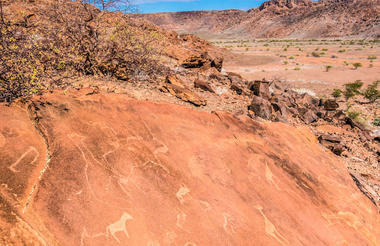
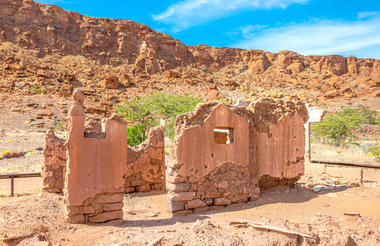
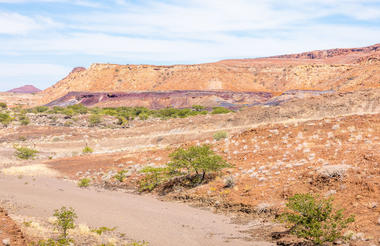
From here we head deeper into the desert and pass Namibia’s highest mountain, The Brandberg, (2573 m) and more beautiful Damaraland scenery. We make a stop in the small town of Uis, an old mining town, and one of the best places to buy semi-precious stones, for which Namibia is famous. Here, rough Amethyst, Tourmaline etc. can be found at bargain prices.
From here we turn directly west and cross the gravel plains on our way to the Atlantic Ocean and the Skeleton Coast. Meeting the ocean at Henties Bay, we first head north along the coast to visit the seal colony at Cape Cross. At certain times of the year as many as 100,000 Cape Fur seals congregate. The seals can be viewed from a walkway at a distance of roughly 200 metres
The next destination is Swakopmund, following the Skeleton Coast into Namibia’s premier seaside town. We aim to arrive in the late afternoon giving us time to explore the town on foot before sunset. Founded in 1892 as the main harbour for German South West Africa, Swakopmund is often described as being more German than Germany. Now a seaside resort, Swakopmund is the capital of the Skeleton Coast tourism area and has plenty to keep visitors happy. The quirky mix of German and Namibian influences, colonial-era buildings and the cool sea breeze make it very popular.
Tonight we take the chance to sample one of the excellent restaurants. The seafood in Swakopmund is superb. Your guide will offer to organise a group meal in a local restaurant for this evening. Participation is recommended but by no means required.
The drive back to Windhoek today will take about 4 and a half hours. We will depart around lunch-time, giving us time to spend the morning relaxing in Swakopmund. It has many superb shops, a good stretch of beach (although the Atlantic here is quite cold) and an open-air curio market. There is also a very good museum and the Namibian National Marine Aquarium is located in Swakopmund.
Alternatively, there are various optional activities that can be arranged. These include aeroplane and microlight flights over the desert, scenic drives, fishing trips (both from the beach or in a boat), four-wheel motorcycle (quad bike) trips into the desert and over the sand dunes around Swakopmund, sand boarding trips (also in the dunes), skydiving, surfing, bird-watching and many other activities are available.
Your tour guide will discuss all the possible options with you before you reach Swakopmund and will offer to make bookings in advance of your arrival. (N.B. All extra activities and excursions in Swakopmund are subject to availability and are made at the client’s own risk and expense).
This is the last day of our trip and after lunch we will transfer back to the capital city where you will be dropped off at your accommodation in the late afternoon / early evening.




